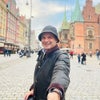Strasbourg Cathedral or the Cathedral of Our Lady of Strasbourg (french: Cathédrale Notre-Dame-de-Strasbourg, deutsch: Liebfrauenmünster zu Straßburg) is a Roman Catholic cathedral in Strasbourg, France. Although considerable parts of it are still in Romanesque architecture, it is widely considered to be among the finest examples of high, or late, Gothic architecture. Erwin von Steinbach is credited for major contributions from 1277 to his death in 1318.
At 142 metres, it was the world's tallest building from 1647 to 1874. It remained the tallest church in the world until 1880, when it was surpassed firstly by Cologne Cathedral and then the 161 metre Ulm Münster. Today it is the sixth-tallest church in the world.
Described by Victor Hugo as a "gigantic and delicate marvel", the cathedral is visible far across the plains of Alsace and can be seen from as far off as the Vosges mountains or the Black Forest on the other side of the Rhine.
An Al-Qaeda plot to bomb the adjacent Christmas market was prevented in 2000 by French and German police.
The site of the Strasbourg cathedral was used for several successive religious buildings, starting from the Roman occupation (when a Roman sanctuary occupied the site) up to the building that is there today.
It is known that a cathedral was erected by the bishop Saint Arbogast of the Strasbourg diocese at the end of the seventh century, on the base of a temple dedicated to the Virgin Mary, but nothing remains of it today.
In the eighth century, the first cathedral was replaced by a more important building that would be completed under the reign of Charlemagne. Bishop Remigius von Straßburg (also known as Rémi) wished to be buried in the crypt, according to his will dated 778. It was certainly in this building that the Oaths of Strasbourg were pronounced in 842. Excavations carried out recently reveal that this Carolingian cathedral had three naves and three apses. A poem described this cathedral decorated with gold and precious stones by the bishop Ratho (also Ratald or Rathold). The basilica caught fire on multiple occasions, in 873, 1002, and 1007.
In 1015, bishop Werner von Habsburg laid the first stone of a new cathedral on the ruins of the Carolingian basilica. He then constructed a cathedral in the Romanesque style of architecture. That cathedral burned to the ground in 1176 because at that time the naves were covered with a wooden framework.
After that disaster, bishop Heinrich von Hasenburg decided to construct a new cathedral, to be more beautiful than that of Basel, which was just being . Construction of the new cathedral began on the foundations of the preceding structure, and did not end until centuries later.
The construction began with the quire and the north transept in a Romanesque style. But in 1225, a team coming from Chartres revolutionized the construction by contributing a Gothic architecture style. In order to find money to finish the nave, the Church resorted to Indulgences in 1253. The money was kept by the Oeuvre Notre-Dame, which also hired architects and stone workers.
Sandstone from the Vosges used in construction gives the cathedral its characteristic pink hue.
Like the city of Strasbourg, the cathedral connects Münster-German and French cultural influences, while the eastern structures, e.g. the choir and south portal, still have very Romanesque features.
Above all, the famous west front, decorated with thousands of figures, is a masterpiece of the Gothic era. The tower is one of the first to rely substantially on craftsmanship, with the final appearance being one with a high degree of linearity captured in stone. While previous façades were certainly drawn prior to construction, Strasbourg has one of the earliest façades whose construction is inconceivable without prior drawing. Strasbourg and Cologne Cathedral together represent some of the earliest uses of architectural drawing. The work of Professor Robert O. Bork of the University of Iowa suggests that the design of the Strasbourg facade, while seeming almost random in its complexity, can be constructed using a series of rotated octagons.
The north tower, completed in 1439, was the world's tallest building from 1647 (when the spire of St. Mary's church, Stralsund burnt down) until 1874 (when the tower of St. Nikolai's Church in Hamburg was completed). The planned south tower was never built and as a result, with its characteristic asymmetrical form, the Strasbourg cathedral is now the premier landmark of Alsace. One can see 30 kilometers from the observation level, which provides a view of the Rhine banks from the Vosges all the way to the Black Forest.
In April 1794, the Enragés who ruled the city started planning to tear the spire down, on the grounds that it hurt the principle of equality. The tower was saved, however, when in May of the same year citizens of Strasbourg crowned it with a giant tin Phrygian cap. This artifact was later kept in the historical collections of the city until they were all destroyed in 1870.
During World War II, the stained glass was removed from the Strasbourg Cathedral and stored it in a salt mine near Heilbronn, Germany. After the war, it was returned to the cathedral by the Monuments, Fine Arts and Archives section of the United States military.Шаблон:Fact
The cathedral's south transept houses an 18-metre astronomical clock, one of the largest in the world. Its first forerunner was the so-called Dreikönigsuhr ("three-king clock") of 1352-1354, located at the opposite wall from where today's clock is. Then starting in 1547 a new clock was built by Christian Herlin, and others, but the construction was interrupted when the Cathedral was handed over to the Roman Catholic Church. Construction was resumed in 1571 by Conrad Dasypodius and the Habrecht brothers, and this clock was astronomically much more involved. It also had paintings by the Swiss painter Tobias Stimmer. That clock functioned into the late 18th Century and can be seen today in the Strasbourg Museum of Decorative Art.
The clock existing today originated in 1838-1843 (the clock has 1838-1842, but the celestial globe was only finished on June 24, 1843) and was built by Jean-Baptiste Schwilgué in Dasypodius' clock case, and with roughly the same functions, but equipped with completely new mechanics. Schwilgué made a number of preliminary studies years before, such as a design of the computus mechanism (Easter computation) in 1816, and built a prototype in 1821. This mechanism, whose whereabouts are now unknown, could compute Easter following the complex Gregorian rule.
The astronomical part is unusually accurate; it indicates leap years, equinoxes, and much more astronomical data. Thus it was already much more a complex calculating machine than a bare clock. Often the complicated functioning of the Strasbourg Clock made specialized mathematical knowledge necessary (not just technical knowledge).
A mathematical marvel, the clock was able to determine the computus (date of Easter in the Christian calendar) at a time when computers did not yet exist.
Easter had been defined at the First Council of Nicaea in A.D. 325 as "the Sunday that follows the fourteenth day of the moon that falls on March 21 or immediately after". (See also Easter controversy, Ecclesiastical new moon, and Paschal Full Moon.)
Today tourists see only the remarkably sculpted figurines of this clock, but behind this ensemble there is an exceptional mechanism that engages and that represents one of the most beautiful curiosities of the Cathedral.
The animated characters launch into movement at different hours of the day. One angel sounds the bell while a second turns over an hour-glass. Different characters, representing the ages of life (from a child to an old man) parade in front of Death.
On the last level are the Apostles, passing in front of Christ. The clock shows much more than the official time; it also indicates solar time, the day of the week (each represented by a god of mythology), the month, the year, the sign of the zodiac, the phase of the moon and the position of several planets. All these automatons are put into operation at 12:30 PM.
According to legend, the creator of this clock had his eyes gouged out afterward, to prevent him from reproducing it. Similar legends are told for other clocks, such as the astronomical clock in Prague.
In the same room, there is a statue of a man resting his elbows on a balustrade (railing). According to legend this was a rival architect to the one who had built the pillar of angels, the architectural feat of the era, who contended that one single pillar could never support such a large vault, and he would wait to see the whole thing come crashing down.
There are several models of the Strasbourg clock, usually with simplified functions. One is in the Sydney Powerhouse Museum [1].
From 1858 until 1989, the clock was taken care of by the Ungerer company. This company was founded in 1858 by two brothers who were Schwilgué's assistants. Since 1989, the clock has been taken care of by Alfred Faullimmel and his son Ludovic, for the Strasbourg cathedral. Mr. Faullimmel had been employed by Ungerer between 1955 and 1989.
The 1976 film Monsieur Klein, set in France in 1942, takes place largely in Paris but in one sequence, in the middle of the film, the protagonist visits his father in Strasbourg. The Cathedral can be seen out a window, and there is a brief shot inside the Cathedral of the astronomical clock's figurines moving about and striking the hour.
The Dutch progressive rock band Focus dedicated a theme to the cathedral in their 1974 album Hamburger Concerto.
One legend says that the building rests on immense piles of oak sinking into the waters of an underground lake. A boat would roam around the lake, without anyone inside, though the noise of the oars could be heard nevertheless. According to the legend, the entry to the underground lake could be found in the cellar of a house just opposite the cathedral. It would have been walled up a few centuries ago.
The legend of the wind blowing around the cathedral is as follows: In olden days, the Devil flew over the ground, riding the wind. Thus he caught a glimpse of his portrait carved onto the cathedral: the Tempter, courting the foolish virgins (Matthew 25:1-13), in the guise of a seductive young man. It is true that his back opens up and toads and snakes come out of it, but none of the naïve girls notices that — nor do many tourists for that matter. Very flattered and curious, the Devil had the idea to enter to see whether there were other sculptures representing him on the inside of the cathedral. Taken captive inside the holy place, he could not come back out. The wind always waits in the square and still howls today from impatience on the places outside the cathedral. The Devil, furious, makes air currents from the bottom of the church to the height of the pillar of angels.





